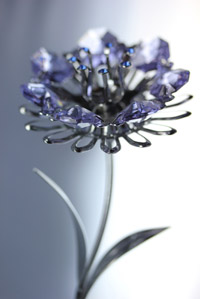Swarovski Crystals, Austria
 Once, in a different century, in a different world, Daniel Swarovski, a young man from Bohemia, invented, then patented a machine that could cut crystal stones with precision and consistency.
Once, in a different century, in a different world, Daniel Swarovski, a young man from Bohemia, invented, then patented a machine that could cut crystal stones with precision and consistency.
With his family, Daniel Swarovski moved to the tiny village of Wattens in the Austrian Tyrol, where his invention could be powered by water. So began a lifetime's journey towards the realization of his shining crystal vision.
1895: The history of Swarovsky crystal begins and a family company is born. The fashion and jewellery industries are revolutionized by the quality and quantity of SWAROVSKI's perfectly cut crystal stones. The small mechanical glass-cutting works in the Tyrol blossoms and thrives over the decades, rapidly turning into an international concern, continually improving, expanding, developing new ideas, offering a wider and wider array of crystal attractions.
After two years of research and development, SWAROVSKI starts to market their own grinding tools and abrasives for cutting crystal stones. The trade name is "Tyrolit".
In 1931, Swarovsky comes up with crystal "trimmings", decorative ready-to-sew edgings and borders, set with crystal stones, pre-setting new possibilities to the fashion world.
In 1937, the launch of ingenious glass reflectors for the road or rail safety, for road lane dividers, or reflective panels for guard-rails. In 1950 these products are named Swareflex.
In 1948, Swarovsky Optics is founded. Wilhelm Swarovski, the eldest son of the founder, had produced the first prototype for a pair of binoculars in 1935.
In 1955, Swarovsky, working with Christian Dior, presents an innovation that takes the world by storm; the Aurora Borealis, a coated crystal stone, flashing with rainbow coloured lights.
In 1965, Swarovsky makes crystal chandelier parts, that in turn create spectacular chandeliers to grace the Metropolitan Opera House and the Palace of Versailles.
In 19967, Swarovsky decides to apply their stone cutting experience and expertise to natural and synthetic gems, including cubic zirconia, the most successful imitation diamond. SWAROVSKI is the first to cut cubic zirconia by mechanical methods.
In 1976, a charming crystal mouse heralds the dawn of a whole new era, as it becomes the first ever animal in Swarovsky's crystal menagerie. This quantum leap, both creative and technical, marks the company's first bold step into the consumer market.
Soon to follow:
1977: Swarovsky's first jewellery line
1987: Foundation of the Swarovsky Collectors Society
1989: The Daniel Swarovsky accessories and jewellery line
1992: Exclusively designed crystal objects
In 1993: Crystal miniatures
In 1988, the company decides to change its Edelweiss logo, essentially Tyrolean, for a new visual identity: the swan, the embodiment of purity, elegance and metamorphosis, has now become known around the world as the mark of SWAROVSKI's dedication to perfection.
In 1995, the history of SWAROVSKI crystal reaches a momentous milestone, as the company celebrates its centenary. The opening of Swarovsky Crystal Worlds in Wattens shows the company in a new role: that of cultural entertainer.
Today, with more than 12,400 employees all over the world, Swarovsky, still family owned and run, is now one of the largest and most successful Austrian companies, with a vast international market for its diverse products. From its birthplace in Wattens in the Austrian Tyrol, crystal conquers the whole world.
Source: swarovski.com